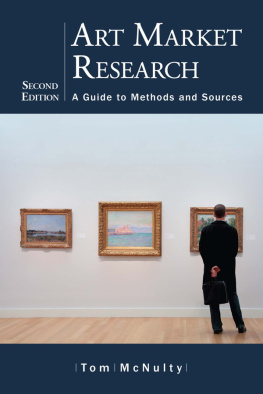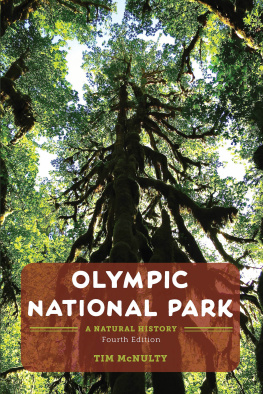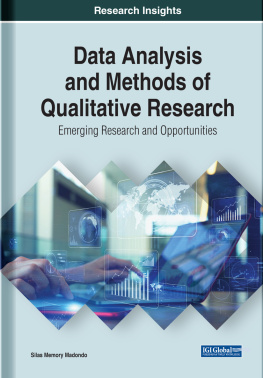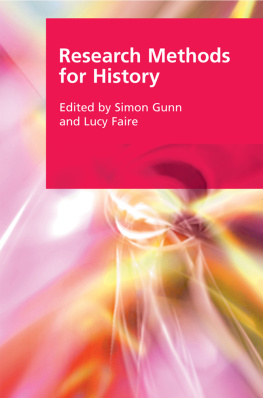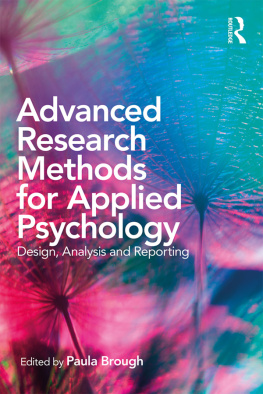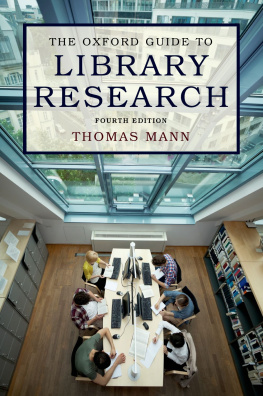
Art Market Research
A Guide to Methods and Sources
Second Edition
Tom McNulty

McFarland & Company, Inc., Publishers
Jefferson, North Carolina
LIBRARY OF CONGRESS CATALOGUING DATA ARE AVAILABLE
BRITISH LIBRARY CATALOGUING DATA ARE AVAILABLE
e-ISBN: 978-1-4766-1397-0
2014 Tom McNulty. All rights reserved
No part of this book may be reproduced or transmitted in any form or by any means, electronic or mechanical, including photocopying or recording, or by any information storage and retrieval system, without permission in writing from the publisher.
A Sothebys preview exhibition of important Impressionist works (courtesy Sothebys, New York)
McFarland & Company, Inc., Publishers
Box 611, Jefferson, North Carolina 28640
www.mcfarlandpub.com
Preface
It occurred to me as I began this revised and enlarged edition of my 2006 Art Market Research: A Guide to Methods and Sources that I never properly introduced the original. As a librarian, appraiser and teacher, I have been engaged in art market research since the late 1980s. In the process of conducting a research project ten or so years ago, I found myself thumbing through one of three thick folders full of printouts and photocopies of print reference works title pages and tables of contents. These folders included my favorite sources for research in fine arts, decorative arts, and other collectible material. Each of the three categories had become so unwieldy, that I decided to put them in books; by books I mean three-ring binders intended to impose some order on these large, and growing stacks of paper. Realizing that an index would make the material truly usable, I decided to write Art Market Research. This edition revises and supersedes the first.
While the desire to impose order on hundreds of bibliographic citations was my primary motivation for the first edition, I wanted it to be more than just another book-length bibliography. My many years of experience as an art librarian at New York University convinced me that researchers at all levelsfrom undergraduate students to tenured faculty members and professional appraiserscould use some direction in the use of reference material, both print and online. This edition includes much of the basic instructional material that appeared in the first edition, but this content is supplemented by an overview of new sources and tools that can greatly empower the contemporary researcher of art and its markets.
During the eight years since the first edition, great advances have been made by the so-called emerging markets for art. The expanding economies of the BRIC (Brazil, Russia, India and China) countries have ushered in a new era in which Western powers hold on the global art market is far less than certain. In fact, Chinathe worlds second largest economynow boasts first place in the market for fine art. With this in mind, Chapter One begins with an overview of the global art world and a brief discussion of its major players and institutions. From artists to dealers to collectors, each section is supplemented by a highly selective list of books that are widely held in libraries. These statistics on library inclusion are derived from the online international catalog WorldCat, which aggregates the inventories of more than 10,000 libraries large and small. WorldCata very powerful reference toolis discussed in much greater detail in Chapter Three as it relates to research in the fine and decorative arts.
A generalized discussion of the art world proceeds to a review of the individual market venues for art, and the processes involved in determining the value of individual works. Chapter Two introduces the factors that impact value, including general popularity of the artist and/or style or period, rarity, various physical properties (e.g., dimensions, materials), provenance and more. The appraisal profession and its three professional associations are described here in some detail.
Chapter Three introduces the basic tenets of research practice, including the proper use of library catalogs, identification of research materials (primarily online databases), and more. New research empowering tools, like search alerts, are explored in detail, and the basic resources needed for both fine and decorative arts research are presented.
Chapters Four and Five explore the more specialized methods and sources available to the researcher of fine and decorative arts, respectively. For the fine art researcher, specialized formats like catalogues raisonns, exhibition catalogs and artists monographs are defined, and tips are offered for their effective use. An overview of the most important general sources (i.e., those that cover a range of media) precedes a lengthy section comprised of media-specific (e.g., painting, prints) tools for the research of an array of artworks. Chapter Five offers the same types of content, proceeding from general resources like dictionaries and encyclopedias to reference materials that focus on specific object types (e.g., furniture, pottery, glass, etc.).
Chapters Six and Seven then proceed to a review of methods and sources that can assist one in determining the monetary value of fine and decorative artworks, respectively. Everything from auction catalogs to published, print-based pricing guides are considered, as are the myriad free and subscription-based Internet sources used by art market research professionals. Note that some of the titles includedespecially in the decorative arts chaptermight seem rather dated. Reference works that were included in the first edition were chosen because they are particularly good, include a vast amount of pictorial content, and are well-organized. I continue to use numerous sources that were published twenty or more years ago, if only for object identification, and so made the decision to retain the majority of these works in the new edition. Sources for very current price data are, however, noted as such and given particularly lengthy discussion.
Whereas any discussion of art and money was until quite recently considered distasteful in many contexts, scholars of art history, economics and related fields have shown great interest in the art market over the past decade, and this interest has engendered a number of interesting research tools for the historian of the art market. Recognizing this fact, Chapter Eight offers a range of resources that can be used to identify the monetary value of fine and decorative arts produced in the years preceding 1960. Journals, books and reference tools that record prices realized by works of art at auction are included here, along with a selection of monographs on art market topics published by important academic presses.
Chapter Nine offers an overview of the basic tools available to the art law and provenance researcher. Provenanceor the record of ownershipis sometimes a powerful value driver in itself, and so methods of discovering the chain of ownership can be central to art valuation research. Included in this chapter are some tips for locating ownership information, along with a basic bibliography of reference resources for general art law research.
Three appendices round out the list of resources available to the contemporary researcher of fine and decorative arts. Appendix A, Art Market Journals, Magazines and Current Awareness Sources, is a highly selective list of newspapers, journals, magazines and freely available Internet-based newsletters that can keep the art market researcher
Next page
